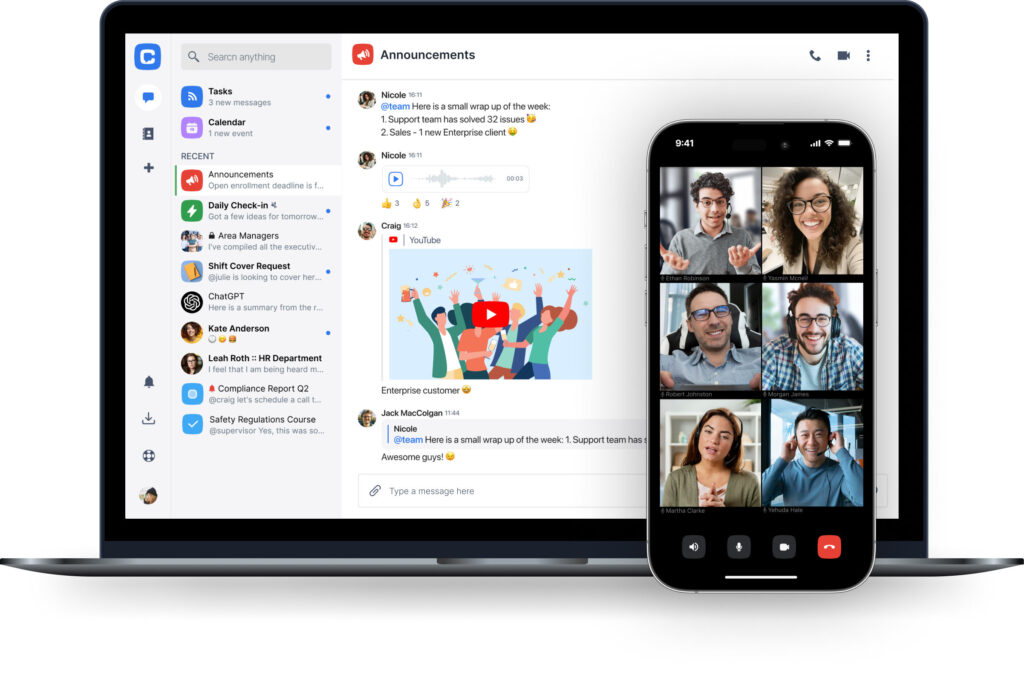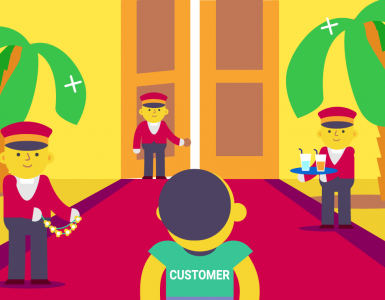In healthcare and life sciences, communication is more than coordination — it’s care itself. A single delay, a missed update, or a message lost in the noise can mean real consequences for patients. That’s the reason why clinical communication is far more than collegial conversation now. It is a structured, high-stakes info sharing with roles, departments, and facilities involved.
And yet, the majority of hospitals, clinics, and research facilities still employ outdated methods —pagers, disjointed email threads, or unsecured messaging apps. These were not built for the speed, complexity, or confidentiality of today’s care environments. They simply are not capable of keeping up with the growing demands for real-time collaboration, secure data sharing, and HIPAA-compliant messaging.
This is where the shift happens. A new generation of clinical communication and collaboration software has emerged — not just to improve workflow, but to protect privacy, support fast decision-making, and enable safe, streamlined teamwork across the care continuum.
In this article, we’ll explore the heart of clinical communication — what it is, who’s involved, and why it demands more than ordinary tools. We’ll unpack the standards and rules that govern it, including the vital role of HIPAA. And then, we’ll look at the technologies reshaping how clinical teams communicate today.
From features that matter to solutions worth considering — like Chanty, a platform designed with healthcare’s pace and priorities in mind. We’ll walk through how to choose and use the right tools to strengthen communication without compromising care.
Let’s begin with the core: what clinical communication really means, and why getting it right matters now more than ever.
Part 1: Understanding clinical communication
What is clinical communication?
Clinical communication is the structured exchange of medical information between healthcare professionals — and at times, patients — designed to support timely, accurate, and secure care decisions.
But this isn’t just about sharing updates. It’s the connective tissue of healthcare, running through every hospital corridor, lab bench, and digital dashboard. From a surgeon briefing the ICU team to a pharmacist double-checking a prescription, clinical communication links actions to outcomes.
What sets it apart from everyday communication is its urgency and consequence. Messages aren’t just informative — they’re often critical. A delay in lab results or a misread note during a shift change can ripple through departments and impact real lives. In this context, words are decisions in motion.
And because the stakes are high, so is the standard. Clinical communication spans a wide network: physicians, nurses, researchers, lab techs, admin teams, and patients. Each interaction must go beyond being heard — it must be understood clearly, without distortion or delay.
To maintain that clarity, clinical communication follows a structure. Protocols guide how information flows, and compliance frameworks like HIPAA safeguard privacy and trust. When breached, the damage isn’t only financial — it’s deeply personal.
That’s why clinical communication isn’t a soft skill — it’s a clinical competency. It demands fluency in medical language, ease with digital tools, and a constant awareness of what’s at stake. In a setting where time is measured in outcomes, there’s no room for missteps.
All of this, of course, must happen quickly — across locations, systems, and shifting teams. So before diving into clinical communication platforms and tools, let’s first examine what clinical communication truly requires. What makes it effective? What principles guide it? And what happens when it breaks down?
Key principles of clinical communication
The pace of healthcare is relentless. In the rush of handovers, consultations, and cross-department updates, clinical communication must function as an integral part of daily operations.
To be effective, it must be guided by a few core principles:
- Clarity over confusion – Every message should be sharp, direct, and actionable. Misunderstandings can lead to errors; clarity prevents them.
- Speed with precision – Information must flow in real time but never at the cost of accuracy. The right person needs the right message at the right moment.
- Context-driven exchange – Communication must be tailored to its audience. A nurse’s needs differ from those of a surgeon or pharmacist. Messages should be aligned with task, role, and urgency.
- Confidentiality by default – Patient data must be protected at all times. HIPAA compliance is not a box to tick—it’s a foundation of trust.
- Empathy in delivery – Even under pressure, communication must remain professional and compassionate. Precision matters, but so does tone.
These principles ensure communication stays purposeful, responsive, and safe. And because the demands are so specific, specialized clinical communication software have evolved to meet them — offering a more secure and effective alternative to traditional tools.
What clinical communication requires from providers and patients — and the role of HIPAA
Knowing what makes clinical communication effective is only part of the story. The deeper question is: What does it ask of the people involved?
Every message, update, and alert involves human judgment and responsibility. For healthcare professionals, communication requires not only clarity and speed but also presence. It’s about balancing urgency with empathy, and accuracy with emotional awareness.
A nurse handing over a shift. A physician speaking with a worried family. A specialist coordinating across departments. Each interaction must be secure, accurate, and mindful — because even the smallest misstep can carry real consequences.
Patients, too, play an active role in this exchange. They bring fear, confusion, questions — and a fundamental right to understand what’s happening. Clinical communication should serve as a bridge, connecting patients to their care teams with transparency, inclusion, and dignity.
Holding it all together is HIPAA — the invisible framework that ensures communication stays ethical, legal, and secure. More than paperwork, it’s the standard that defines how information is shared, stored, and protected.
For providers, that means every message, system, and tool must follow strict data privacy rules. And in a world of digital communication, it’s no longer just about compliance — it’s about creating a culture where privacy, safety, and clarity coexist in every interaction.
Part 2: Clinical communication software and collaboration platforms
So far, we’ve explored the critical nature of clinical communication, its intricate demands, and how integral it is to healthcare. It’s clear that this is no longer a function that can be managed with fragmented tools or left to chance.
While traditional methods like post-its and phone calls were once sufficient, modern healthcare moves at a much faster pace. Teams now collaborate across multiple departments, sometimes spanning campuses, while patients often require care from a range of professionals. In this fast-paced environment, time is always a limiting factor.
Enter clinical communication software, designed not out of necessity for new software, but because the complexity of healthcare demands more. These platforms go beyond hallway updates and casual texts; they provide a secure, reliable, and flexible solution to the communication needs of modern healthcare.
These platforms evolved over time — from paging systems to secure messaging and now fully integrated communication and collaboration solutions. Today, they streamline everything from lab results and prescriptions to patient status updates and specialist consultations, all shared in real-time with the right stakeholders.
For clinicians, the shift isn’t just about convenience; it’s about safety, coordination, and ensuring that no critical moment is missed. For patients, it’s about trust—knowing their care team is connected, informed, and responsive.
The best clinical communication software
In the fast-paced world of healthcare, where timely, accurate information exchange is vital, clinical communication platforms have become indispensable. These tools go beyond simple messaging to create an integrated communication ecosystem that supports the complex workflows of healthcare professionals.
| Platform | HIPAA Compliant | Secure Messaging | EHR Integration | Task Management | On-Call Scheduling | Mobile/Desktop Access | AI Assistance | Best For |
| Chanty | ✅ | ✅ | ❌ | ✅ | ❌ | ✅ | ❌ | Interdisciplinary teams needing streamlined chat |
| Connecteam | ✅ | ✅ | ❌ | ✅ | ❌ | ✅ | ❌ | Multi-site teams, mobile coordination |
| TigerConnect | ✅ | ✅ | ✅ | ✅ | ✅ | ✅ | ❌ | Enterprise hospitals, rapid response |
| symplr (Halo Health) | ✅ | ✅ | ✅ | ✅ | ✅ | ✅ | ❌ | Acute care settings |
| OnPage | ✅ | ✅ | ❌ | ❌ | ✅ | ✅ | ❌ | Critical alerting, incident response |
| Buzz Messenger | ✅ | ✅ | ❌ | ✅ | ❌ | ✅ | ❌ | Small to mid-sized clinics |
| Microsoft Dragon Copilot | ✅ | ✅ | ✅ | ✅ | ❌ | ✅ | ✅ | AI-powered documentation and care |
- Connecteam
Ideal for: Nurses, home health aides, and multi-site support teams.
Connecteam is designed with frontline healthcare workers in mind. It centralizes essential communication with HIPAA-compliant messaging, customizable forms, and digital checklists — perfect for mobile staff who need instant updates on the go. Supervisors can assign and track tasks, ensuring accountability without chasing paperwork. It’s especially useful in settings like long-term care facilities, home health services, or large clinics where not everyone is desk-based.- Why it fits: Empowers mobile teams to stay connected, organized, and compliant — even when they’re on different floors, shifts, or sites.
- TigerConnect
Ideal for: Physicians, hospitalists, specialists, and care coordination teams.
TigerConnect enables seamless communication across departments and roles. Its integration with EHR systems allows clinicians to send patient updates or lab results in real time. Nurses can alert physicians without relying on pagers, while administrators benefit from advanced analytics on communication flow.- Why it fits: Reduces communication lag in hospitals and emergency settings, improving care transitions and response time — a must-have for large institutions or those managing critical care.
- symplr Clinical Communications (formerly Halo Health)
Ideal for: Charge nurses, care coordinators, and on-call scheduling teams.
Built specifically for acute care environments, symplr handles the intricate coordination required in hospitals. It simplifies complex on-call scheduling, letting teams know who’s available instantly — no need to flip through paper charts or chase down colleagues. Its secure chat and alert features also help reduce care fragmentation.- Why it fits: Streamlines care team communication and shift coordination, helping ensure no patient or task falls through the cracks in high-pressure settings.
- OnPage
Ideal for: Rapid response teams, IT incident managers, and clinical leadership.
OnPage is more than just secure messaging — it’s built for critical communications. With built-in escalation rules and delivery confirmations, it ensures alerts are never missed. For example, a nurse can trigger an urgent cardiac alert that will escalate to the next available provider if there’s no response.- Why it fits: Perfect for high-risk workflows, like critical care or behavioral health, where timing is everything and accountability needs to be traceable.
- Buzz Medical Messenger by Skyscape
Ideal for: Private practices, outpatient teams, and telehealth providers.
Buzz is lightweight, intuitive, and easy to deploy. It combines HIPAA-compliant texting, group messaging, and even voice and video options. Small clinics or specialty providers can use it to stay in sync without overwhelming staff with overly complex systems.- Why it fits: Offers a streamlined communication hub for smaller practices that still need to maintain high standards of coordination and care continuity.
- Microsoft Dragon Copilot
Ideal for: Physicians, nurse practitioners, and administrative staff.
Dragon Copilot brings AI into the daily routine of clinical documentation. With voice recognition and ambient listening, it captures conversations and auto-generates progress notes, freeing clinicians from typing or dictating notes later. It integrates with EHRs, helping reduce burnout while maintaining compliance.- Why it fits: Transforms how providers interact with records and documentation — saving time, reducing errors, and allowing more focus on patients.
Why Chanty could be the perfect option for clinical teams

With so many tools in the digital landscape, it’s not just about messaging; it’s about supporting real-time care, ensuring security, and giving healthcare professionals one less thing to worry about in a fast-paced environment. This is where Chanty truly shines.
Chanty isn’t just another messaging tool. It’s a comprehensive communication platform designed to meet the specific needs of healthcare teams. It balances simplicity on the surface with powerful capabilities underneath — precisely what medical teams require.
First and foremost, Chanty is HIPAA-compliant, ensuring the highest standards of data security. Whether discussing lab results, medication updates, or team availability, patient data remains secure every time.
Chanty’s private, secure messaging system enables providers to communicate quickly and confidently within a protected environment. For broader updates — such as protocol changes or shift schedules — company-wide announcements replace the need for email chains and physical notice boards.
Another key feature is customizable permissions. Whether organizing communication by department, specialty, or role, this feature prevents information overload and ensures staff only see what’s relevant to their responsibilities, streamlining communication across teams.
Designed for both desktop and mobile devices, Chanty keeps teams connected regardless of location. Whether on a hospital floor, in a clinic, or remotely, everyone stays in sync — no matter the pace of the day.
Additionally, Chanty doesn’t disrupt existing workflows — it complements them. With seamless integration into the tools healthcare teams already use, it reduces logins, minimizes context-switching, and allows providers to focus more on what truly matters: delivering quality care.
For healthcare providers looking for a scalable, secure communication solution that enhances collaboration without compromising on speed, clarity, or security, Chanty is a smart choice. It’s not just about communication — it’s about ensuring the team moves together as one.
Wrapping up
In the ever-evolving world of healthcare and life sciences, clinical communication is no longer just a support system — it’s a living, breathing part of patient care. From understanding what clinical communication truly is, to navigating the principles it stands on, and finally choosing the right tools to sustain it, we’ve traveled through the very heart of how modern care teams stay connected.
What becomes clear is this: technology may carry the message, but it’s the people who shape the meaning. Clinical communication software and collaboration platforms are here to serve, not complicate, the essential work being done every hour of every day. But using them responsibly is not optional. With the sensitivity of patient data and the high stakes of clinical decisions, the tools we choose must be paired with a deep understanding of how to use them safely.
So, a few ground rules worth keeping close:
- Only use HIPAA-compliant platforms when handling patient information. This is your legal and ethical shield.
- Be cautious with permissions. Not everyone needs to see everything. Tailored visibility keeps information precise and secure.
- Avoid personal devices or unsecured apps for professional communication, unless you’re sure they meet the standards.
- Educate your team—clinical communication is only as strong as its weakest link.
- Regular audits and reminders help keep good habits fresh and reduce risk over time.
When used with care and intention, clinical communication and collaboration software can become more than just a convenience—it becomes a quiet partner in the pursuit of better outcomes.
And if you’re searching for a solution that blends reliability, simplicity, and compliance — Chanty is ready to step in. It’s built for teams who need to move fast, share securely, and stay aligned in every moment that counts.
Ready to see how it fits into your clinical flow? Give Chanty a try — because better communication is better care.








